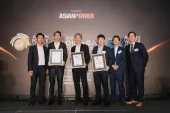
Oracle Utilities leads modernisation of energy sector in Asia
It is focused on promoting the shift to smart meters and advanced metering infrastructures.
Recovery in the APAC region is projected to be uneven. The various COVID-19 lockdowns across the region have resulted in overall power demand reductions and increased home energy usage. Whilst there are signs of turnarounds in APAC, this will be mostly led by countries such as China but lesser in other countries.
Oracle Utilities’ Nick Birrell, Vice President, Industry Strategy, Oracle Utilities JAPAC, said that the challenge facing the global energy sector is the so-called “3D’s” of decarbonization, decentralized energy generation, and digitisation imperative.
“On the decarbonization front, the major northeast Asian economies of Japan, South Korea, and China have all recently pledged to transition to net-zero carbon by the second half of the century. Similarly, a large proportion of South East Asia and South Asian countries have also recently made net-zero commitments, along with individual Australian states and New Zealand,” he said.
“This will further accelerate the trend of distributed energy, such as solar and wind. As increasing amounts of decentralized energy resources (DERs) are connected to the grid, we are observing increasing numbers of APAC utilities turning to digital technologies and smart grids to better manage the impact of all these newly installed DERs on the grid,” he added.
Birrell said that this digitisation trend will only accelerate as the need to better manage system flexibility, reduce peak loads, and improve grid reliability become even more acute.
This is complemented by the continuing market reforms observed across the region in the past year.
“For example, Vietnam's drive to open a competitive energy market, the reform of the Philippines spot market to five minutes, changes to wholesale market arrangements in China, and ongoing reforms to India's distribution companies and markets,” he said.
With these developments, he said that investing in smart meters and advanced metering infrastructure (AMI) will enable utilities to transform and embrace new ways of doing business.
One example of this benefit is how AMI data disaggregation opens a wide range of benefits from driving demand-side response initiatives to opening new revenue streams by selling more efficient appliances to customers.
“AMI is an important contributor to grid reliability in the sense that voltage data from individual AMI meters are processed by the distribution management system (DMS) and can be used by grid operators to develop distribution system models and optimize voltages across the grid. Displaying voltage at each meter on a DMS SCADA diagram will help dispatchers instantly view and monitor network conditions at a glance,” Birrell said.
“Smart meters will also be at the forefront of opening new energy business models, such as transactive and peer-to-peer models. With developments such as these, many more artificial intelligence and machine learning use cases will be imagined, especially when this data is combined with other data sources, including Internet of Things sensor data,” he added.
According to Birrell, Oracle Utilities is committed to providing industry-leading solutions across the energy value chain. Corollary to that is they are equipped to navigate with highly secure, highly accessible, and highly available cloud infrastructure to further the digitisation ambitions of utilities worldwide.
“The global smart meter market is not slowing down. According to Allied Market Research, the smart meter market is projected to grow at a compound growth rate of nearly 9% per annum over the next six years. The Asia Pacific region is expected to be the largest market, mainly due to China and India,” he said.
“AMI will become a critical part of the larger arsenal that utilities, regulators, and governments alike must leverage to transition to a clean, sustainable, resilient grid. AMI is the prerequisite to achieving modern customer insights and operational efficiencies and improvements,” he added.
Of course, modernisation is without its own challenges. Birrell said that another crucial factor is how customers will engage and embrace these new developments. As the industry moves to a more digital forefront, the need for engagement also increases.
“A challenge we often see is the failure to realise that an effective smart meter deployment is less an infrastructure project and more a customer engagement project. A large portion of the smart meter business case will be linked to customers acting on the data,” he said.
“Therefore, utilities need to up their customer engagement game to ensure consumers understand the benefit to them and can act on it. Consequently, we see utilities increasingly investing in modern digital customer engagement platforms,” he concluded.



















 Advertise
Advertise






